Flash Bang History: Making a Home in A Former Gunpowder Factory
By Mary Angeles Armstrong | Photos by Winona Barton-3Ballentine | Summer 2021 | Features | House Feature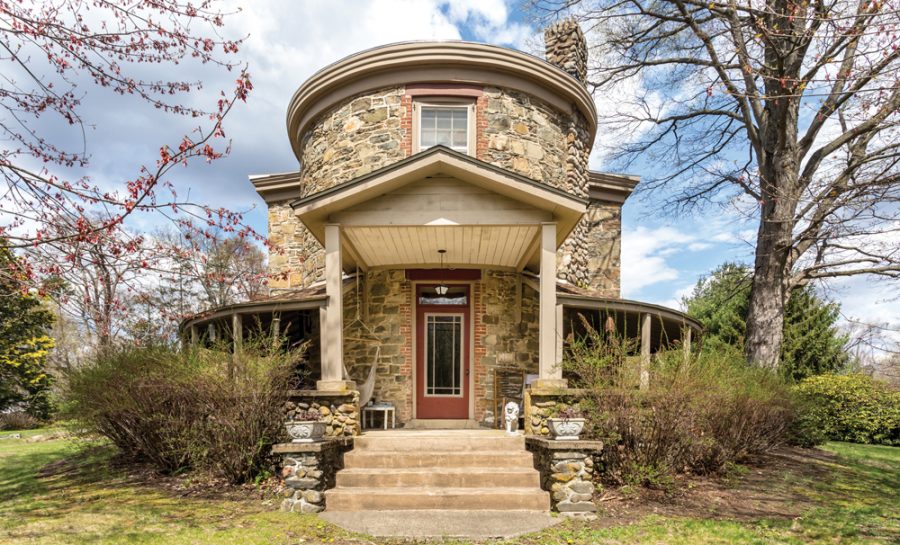
Richard Rabinowitz revels in uncovering his home’s murky past. “Even the roofer gave me a history lesson,” Rabinowitz explains of a recent maintenance project. “I climbed up with him and he showed me 192 years of roof repairs.” It seems there are many stories buried under those eves. Built in the 1820s, the Federalist-style house he shares with wife, Jill Enfield, features a street side rotunda and solid stone walls. Originally the headquarters for the Orange Mill gunpowder company, the home and adjacent park were once central to Newburgh’s thriving gunpowder industry.
Enfield’s work is explosive in its own right. Utilizing the 19th-century wet-plate collodion process, she captures images by applying a coat of nitrocellulose—an explosive also used in rockets—onto glass, creating portraiture that exposes her subjects in flashes of illumination. Her work synthesizes the past with the present: The subjects are current, but the themes she explores are perennial and her creative process subverts her home’s historic beginnings with a creative bang.
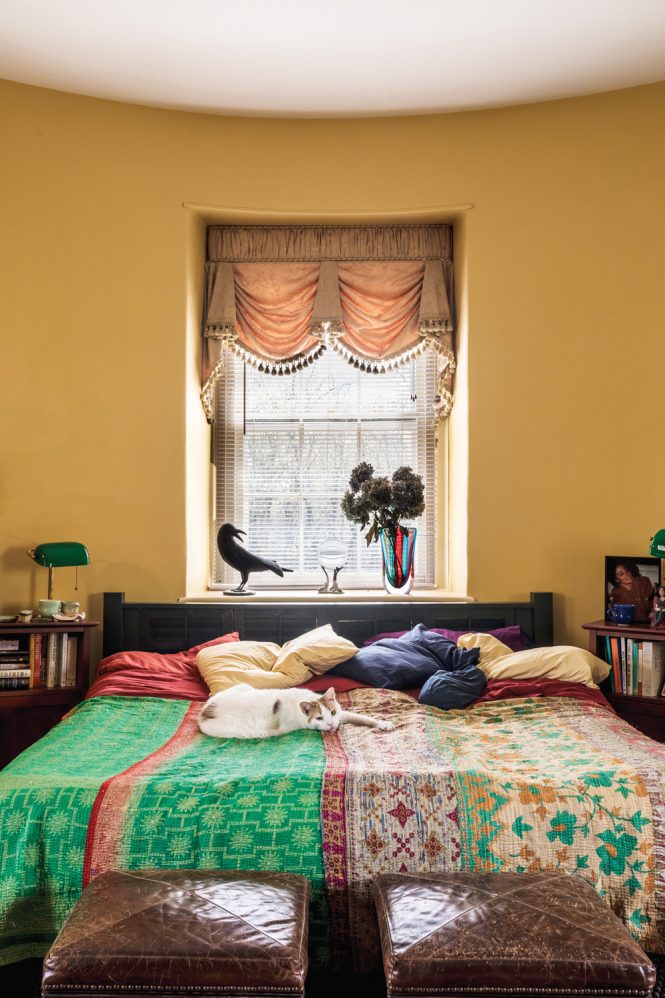
The second-floor primary bedroom is the same round footprint as the first floor living room. The couple decorated the space with furniture brought from Germany in 1939 and art from their childhood homes. “I love standing in the middle of the room because you can hear an echo,” explains Enfield. “Even though we are on a busy street, the walls are so thick that the house is very quiet.”
To create her most recent work, the “New Americans” series, Enfield printed pictures of recent immigrants onto 45 discarded windows and then built a glass house from the portraits that were, quite literally, exploded onto the glass. The installation was first displayed at Ellis Island and then in multiple other locations. “Collodion is made from gun cotton,” says Enfield, describing the common term for nitrocellulose, the volatile sibling of gunpowder—smokeless but more explosive. “It’s ironic that we ended up in a gunpowder mill, we’ve really come full circle.”
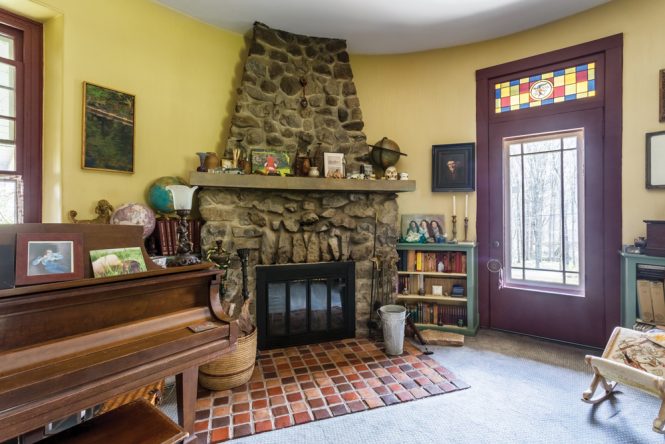
The round living room was once used as a test
lab for the gunpowder mill. When the mill was converted to a residence, the fireplace was added, along with a plaque commemorating workers who had died on the premises. The Steinway Parlor Baby Grand piano has been in Rabinowitz’s family since the 1950s. Since moving to the area in 2014, the couple have collected multiple works by local Hudson Valley painters, including the painting of a red chair on the fireplace mantel by Anna West.
Set in Stone
“We’ve always liked places that exude history,” says Enfield. “As well as places that were well built, so it was hard not to fall in love with this house the moment we drove up to it.” In 2014 the couple decided to leave city life behind. Rabinowitz, who had worked in advertising as well as publishing, began organizing photo workshops through his business, the Digital Photo Academy, and was no longer based in New York City. The pair still needed an easy commute into Manhattan, however, where Enfield continues to teach at Parsons School of Design. “Grand Central Station is one of my favorite buildings,” she explains, “so we began searching along the lines that travel there.” They soon found Newburgh—central to the Hudson Valley’s many charms and relatively walkable. The historic, 3,300-square-foot, two-story home with its colorful history fit them to a T.
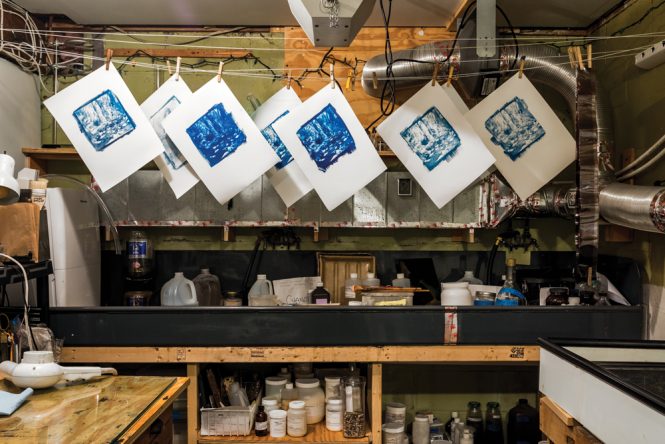
Enfield, a photographer known for her expertise
in alternative and historic techniques, maintains a large dark room and office in the home’s basement. Hanging above the sink are a line of experimental cyanotypes for an online class Enfield is leading.
The former headquarters-turned-stately home sits on a hill overlooking the Round House gunpowder mill, known affectionately by some Newburgh locals as the “Witches Castle,” and now maintained as part of the Algonquin Park historic district. The mill was originally built in the 1700s and first used to produce chalk and then lumber. Asa Taylor, a local businessman, bought it in 1816, along with more than 300 acres of surrounding land, and converted the mill to manufacture gunpowder. Under a series of owners, it became known as the Orange Mill gunpowder complex.
According to local historian Joe Santacroce, the convex design of the gunpowder mill worked to deter the impact of accidental blasts. “They must have experienced one or more blasts prior to the construction of the offices,” he explains. The Orange Mill officials decided to incorporate the shape of the Round House mill when they designed their headquarters in the 1820s.
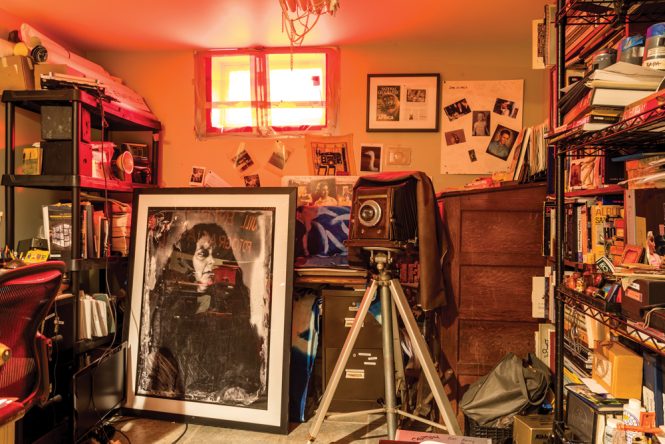
In Enfield’s office is one of her first self-portraits, created when she was trying to master the wet- plate collodion process. She took the original photo with the camera pictured, and then printed it onto glass. The print was scanned into her computer and then utilized as the cover of her second book on alternative photographic processes.
The two-story building, which included a first-floor testing laboratory in the large, round front room and a suite of offices above, also included a carpenter’s shop in the rear and a testing range right behind the home, all of it completed by 1828. Initially, the gunpowder “was used to blow up tree stumps as they were building the cities around here and to flatten land for the local roads” explains Rabinowitz. As the operations expanded, the facility also began to manufacture high-quality cannon and rifle powder.
In 1859, the mill was bought by the Smith and Rand Powder Company which ramped up its manufacturing capacity even further, providing gunpowder for the Union Army during the Civil War. According to Rabinowitz the mill changed hands several times and sometime around 1901 the offices were remodeled into a residence. In 1909 the property was bought by Colonel Fredric Delano (uncle of FDR), who preserved the mill and surrounding land. After his niece Sarah Delano (FDR’s mother) inherited the property, she donated it to the city of Newburgh as a historic park.
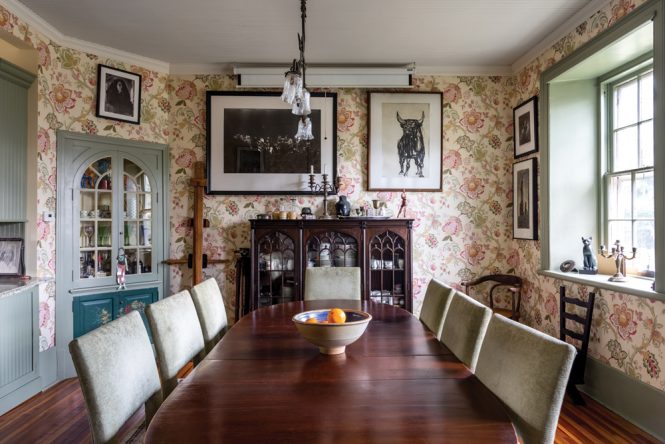
Most of the home’s interior is covered in a variety of wallpaper prints, which provide a colorful backdrop to the couple’s eclectic art collection. The home’s dining room includes photos by various artists and an Edmond Casarella sketch, The Bull, from 1954.
Glass House Explosions
Both Enfield and Rabinowitz tend towards historic preservation and prefer the antique over modern design. “We don’t really like modern construction which seems to reflect a decaying society that has made the priority of built-in obsolescence,” she explains. Together, they’ve amassed a large collection of artifacts, photographs and artwork documenting their family histories and dating back to the 19th century.
Historic documentation runs in Enfield’s family and her work is also inspired, in part, by her family’s own story. “My family has been involved with photography since 1875,” she explains. Natives of Frankfurt, Germany, they operated a camera store there until 1939. At the onset of World War II, the family was able to move to Miami and open a camera store with the help of Ernest Leitz II, the head of the Leica Camera company, who helped smuggle hundreds of Jews out of Germany in what’s become known by historians as the “Leica Freedom Train.” After immigrating, Enfield’s father Kurt joined the United States military, serving with the 7th Division Photographer’s Corp documenting the war in Japan. “The old movie reels shown in theaters during World War II were often filmed by my father or my uncle Paul,” she says.
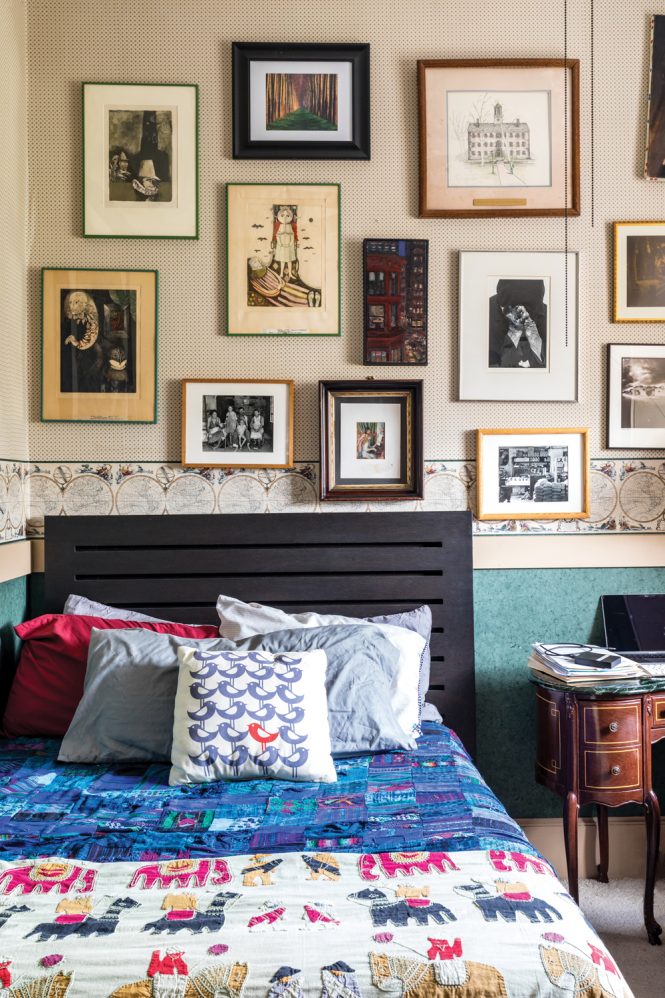
A second-floor guest bedroom is decorated with a mix of images, including three color etchings by Mexican artist Leticia Tarrago; photographs by Lewis Hine and Abe Frajndlich; and paintings by Violet Baxter and Jim Marshall. There is also a portrait of Enfield by artist Emilio Klein and a portrait of Rabinowitz as a child.
She followed in her family’s footsteps not only becoming a photographer, but also almost exclusively relying on historic techniques to create her work. “I started using alternative processes almost from the beginning of my career,” she explains. Along with several exhibits, her expertise has produced the book Jill Enfield’s Guide to Photographic Alternative Processes: Popular Historical and Contemporary Techniques.
Bird’s-Eye View of History
The day the couple first happened upon the former Orange Mill Headquarters Enfield told Rabinowitz, “this place is wonderful, but I’m guessing that it will be a disaster inside.” However, they were happily mistaken. Since its gunpowder days, the headquarters had been slowly transformed into a comfortable home that never lost its historic charm. Downstairs, subsequent owners converted the testing laboratory into a large living room, adding a giant stone fireplace with a plaque commemorating a worker who’d died on the premises. (According to Santacroce there are probably multiple burial sites on the grounds from additional accidents.) A covered porch, curved to match the round exterior, was added to the front of the home offering views to the mill.
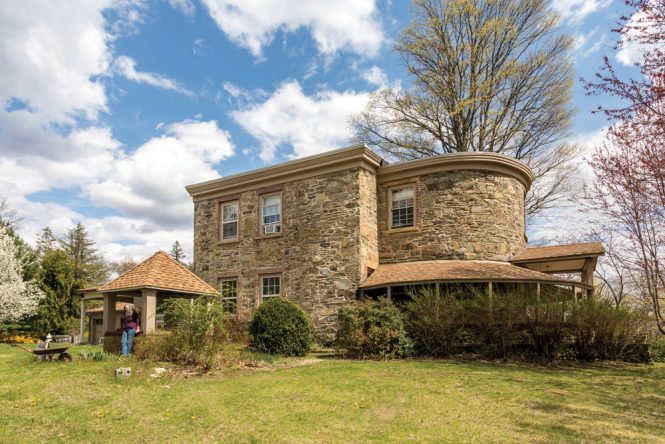
A side view of the house emphasizes the rotunda.
The carpenter’s shop in the back of the building was converted into a mother-in-law apartment and then opened again into an extra bedroom. Between the two spaces an open kitchen and large dining room was added. The cellar—which was once a storage facility complete with underground tunnels leading to the mill across the street—was converted into an additional bedroom. The upstairs offices had become two small bedrooms, an additional sitting room, a bathroom and a circular master bedroom with the same footprint as the testing laboratory downstairs. Former owners also added a pool to the now 1.3 acre grounds.
“It was not only different with its large round frontal area, and historical, but it was very comfortable,” Enfield explains. “The house is not too big but big enough that we can both work here without being in each other’s way.” Right away Enfield realized that the partially finished basement would be perfect for a darkroom. “I was able to build a beautiful old fashioned wet darkroom,” she says. She also has a digital office downstairs and additional storage. On the first floor, Rabinowitz has an office and conversation pit with views over the surrounding landscape. The covered porch and pool area also serve as ad-hoc work spaces.
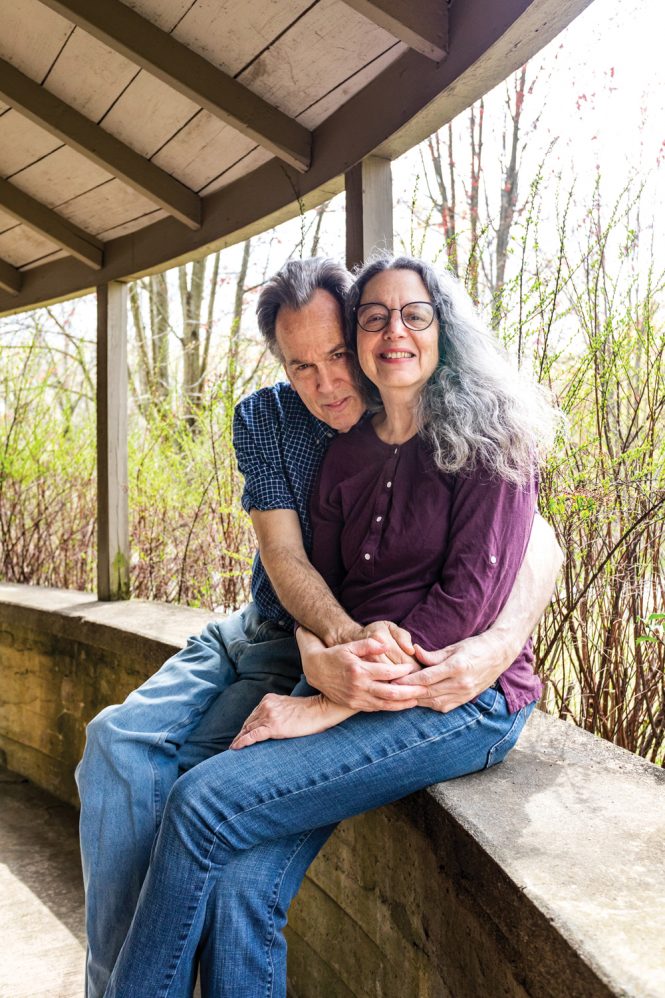
Enfield and Rabinowitz on the covered front porch of their home.
The walls throughout the first and second floors have provided ample space to hang Enfield’s own work and their collection of art, photography and antiques. However, it’s the bird’s-eye view of history that both Rabinowitz and Enfield enjoy the most. “The tall trees create our own private paradise, you see the stars and you feel like you’re in an oasis,” Enfield explains. “But we can always see Algonquin Park across the street from our front porch.”
